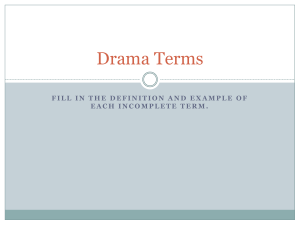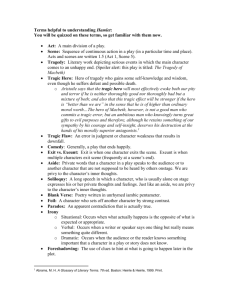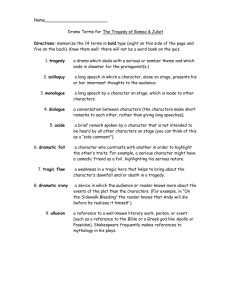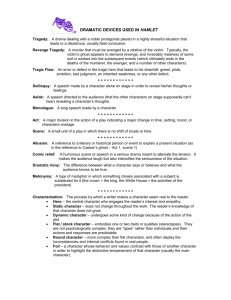Drama Terms - Oakland High School
advertisement
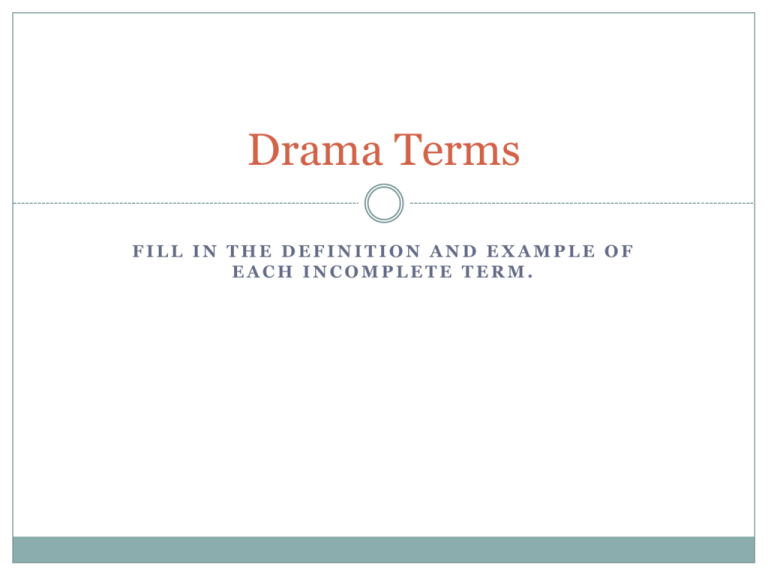
Drama Terms FILL IN THE DEFINITION AND EXAMPLE OF EACH INCOMPLETE TERM. Aside When a character speaks directly to the audience or privately to another character on stage. During an aside, no one else on stage hears the conversation except the audience and the person who is being spoken to. Anachronism When a writer places a person or object outside of its realistic time period. Example: Shakespeare lived in the 1500’s. His places contained references to Queen Elizabeth (who also lived in the 1500’s), even though many of his play’s settings took place before the queen was born. Dialogue Written or spoken conversational language between two or more characters. Dramatis Personae Pronounced : Dram uh tis Per sone ee A list of characters preceding the text in a play. Foil Character A character who contrasts with another character (usually the protagonist) in order to high light particular characteristics in the other character Iamb A metrical foot used in different types of poetry. An Iamb is a short syllable followed by a long syllable. Iambic Pentameter Is acommonly used metrical line in traditional verse (blank verse). A line of poetry written in iambic pentameter will have 10 syllables. Friends, Romans, countrymen, lend me your ears! Metonymy is a figure of speech used in rhetoric in which a thing or concept is not called by its own name, but by the name of something intimately associated with that thing or concept. Examples: Hollywood is a metonym for U.S. cinema Langley is a metonym for the U.S. Central Intelligence Agency whose head quarters are in this town Monologue is a speech presented by a single character, especially one dominating a conversation. It can also be any composition, as a poem, in which a single person speaks alone. They can share their personal ideas but with the intention of giving these thoughts to the audience. (They are not talking to themselves) Pathos A rhetorical device in which someone evokes feelings of pity or compassion in their audience. Pathos deals with one’s emotions. Example: Marc Antony uses pathos in his speech to first evoke the feelings of compassion for Caesar. He then uses this emotion to manipulate the crowd. Soliloquy an utterance or discourse by a person who is talking to himself or herself or is disregardful of or oblivious to any hearers present (often used as a device in drama to disclose a character's innermost thoughts) The character is NOT speaking to anyone but himself or herself. Example: Hamlet's soliloquy begins with “To be or not to be.” Antony: O pardon me thou bleeding piece of earth… Stage Directions an instruction written into the script of a play, indicating stage actions, movements of performers, or production requirements. usually set off with brackets [ ], parentheses( ), or italics Example: Enter, from opposite sides, a Fairy, and PUCK Tragedy any literary composition, as a novel, dealing with a somber theme carried to a tragic conclusion. (most characters usually die in tragedies) Emphasizes human greatness Tragic hero – man of noble stature (usually prince or king) Tragic hero is good (not perfect) Tragic hero has a downfall – (usually of his own fault) However, his misfortune is not altogether deserved Even though the hero may die, he usually learns something about mankind or has some gain in self-knowledge before he dies. Tragedy celebrates life. Challenges us with a vision of human possibility. Tragedies tend to isolate protagonists to emphasize their uniqueness. Tragic Flaw the character defect that causes the downfall of the protagonist of a tragedy Example: Some heroes have PRIDE. Tragic Hero a great or virtuous character in a dramatic tragedy who is destined for downfall, suffering, or defeat: Oedipus, the classic tragic hero. Comedy Exposes or makes fun of human weakness Displays human limitations (humans are not allpowerful) “Lord, what fools these mortals be!” Function: To be critical and corrective Humorous and full of satire Ridiculous characters Comedies place their protagonists in the midst of a group to emphasize their commonness. Many comedies end with marriages ( fun, exciting, and celebratory). There’s more on Comedies Emphasizes the sympathetic character rather than the ridiculous character. Main characters are sensible and good Romantic Comedies do not test the limits of human possibility. Lesser characters are made fun of through ridicule and satire. Tragedy vs. Comedy Plot Structure The structure is basically the same except for a few differences. 1. Comedies- During the falling action (Act IV), something else goes wrong even though all the major decisions have been made. This is called the second conflict 2. Tragedy- In the falling action, something else looks like it will turn the events even though the major mistakes have been made. ( You think it will be alright). This is called the second hope Euphemism Some euphemisms are idioms but not always. Examples: To pass away – to die Croaked – died Full figured- overweight Lose your lunch- regurgitate (throw up) the substitution of a mild, indirect, or vague expression for one thought to be offensive, harsh, or blunt. Pun the humorous use of a word or phrase so as to emphasize or suggest its different meanings or applications, or the use of words that are alike or nearly alike in sound but different in meaning; a play on words. Example: "A trade, sir, that, I hope, I may use with a safe conscience; which is, indeed, sir, a mender of bad soles." The pun is on soul Blank Verse (also called unrhymed iambic pentameter) - unrhymed lines of ten syllables each with the even-numbered syllables bearing the accents. A form of poetry- Shakespeare uses blank verse to show when someone is speaking in the formal language. Free Verse the ordinary form of spoken and written language whose unit is the sentence, rather than the line as it is in poetry. The term applies to all expressions in language that do not have a regular rhythmic pattern A form of poetry also known as PROSE Shakespeare wrote in prose to show when someone was speaking the common language or slang. Rhetoric The art or study of public speaking. Being able to use language effectively within a speech. Rhetorical Devices: Techniques speakers use to influence his or her audience. Rhetorical Question a question asked solely to produce an effect or to make an assertion and not to elicit a reply. Example: “ Did I raise you in a barn?” Marc Antony- "Does this in Caesar seem ambitious?’’ Rhetoric is a synonym for Oratory Oratory (orator) 1. skill or eloquence in public speaking: The evangelist moved thousands to repentance with his oratory. 2. the art of public speaking, especially in a formal and eloquent manner. More Rhetorical Devices Analogy: a comparison in which the writer/speaker finds points of similarity between two dissimilar things, often extending the idea beyond a single sentence. Example: Learning a new language is like being a small child all over again. You find yourself pointing at things, blurting out words, and hoping that someone will understand. Meanwhile, people around you seem to be speaking a mile a minute, laughing with each other, but you have no idea what they’re saying. Frustrated that you can’t express yourself or join in the conversation, you may have the urge to ball up your hands into fists and cry. Parallelism Grammatical Meaning: Similarity of structure in a pair or series of related words, phrases, or clauses. Also called parallel structure. Example of correct parallelism: She is washing the dishes, going to the store, and buying groceries. Example of non-parallel structure: She is going to wash the dishes, going to the store, and to buy groceries. Parallelism Rhetorical Devices meaning: Figure of balance identified by a similarity in the syntactical structure of a set of words in successive phrases, clauses, sentences; successive words, phrases, clauses with the same or very similar grammatical structure. Examples: "Let every nation know, whether it wishes us well or ill, that we shall pay any price, bear any burden, meet any hardship, support any friend, oppose any foe to assure the survival and the success of liberty." -- John F. Kennedy, Inaugural Address More Examples of Parallelism "We have seen the state of our Union in the endurance of rescuers, working past exhaustion. We've seen the unfurling of flags, the lighting of candles, the giving of blood, the saying of prayers -- in English, Hebrew, and Arabic.“ George W. Bush, 9-20-01 Address to the Nation on Terrorism "We have petitioned and our petitions have been scorned. We have entreated and our entreaties have been disregarded. We have begged and they have mocked when our calamity came. We beg no longer. We entreat no more. We petition no more. We defy them."-- William Jennings Bryan Repetition Repeating the same words over and over for dramatic or emotional effect. “Free at last, free at last, thank God almighty we’re free at last!” – MLK Jr. “For Brutus is an honorable man; So are they all, all honorable men” – Marc Antony Shakespearean Play Allusions Reference to anything historical, biblical, cultural, literary, mythological, etc.. "Ay, as Aeneas, our great ancestor, did from the flames of Troy upon his shoulder the old Anchises bear.." (Cassius, Act 1, scene 2) Aeneas was the son of Anchises and Aphrodite. He is associated with the founding of Rome, and his story is told in Virgil's Aeneid. Hyperbole An extreme exaggeration “ I’ve heard that excuse a million times.” Litotes Pronounced: Ly tu tees A deliberate understatement used for emphasis Example: “We had a nice little snack of roast beef, mashed potatoes, green beans, several side salads, and a choice of about a dozen desserts.” Example 2: "Einstein is not a bad mathematician" Metaphors and Similes Metaphor : Her hair was a waterfall flowing down her shoulders. Simile: Her hair looked like a waterfall flowing down her shoulders. Stereotype A generalization that allows a reader to quickly identify a character with a group “During the Cold War, a Russian was an enemy.” Practice Rhetorical Devices EOC Purple Book Pages 267-269
